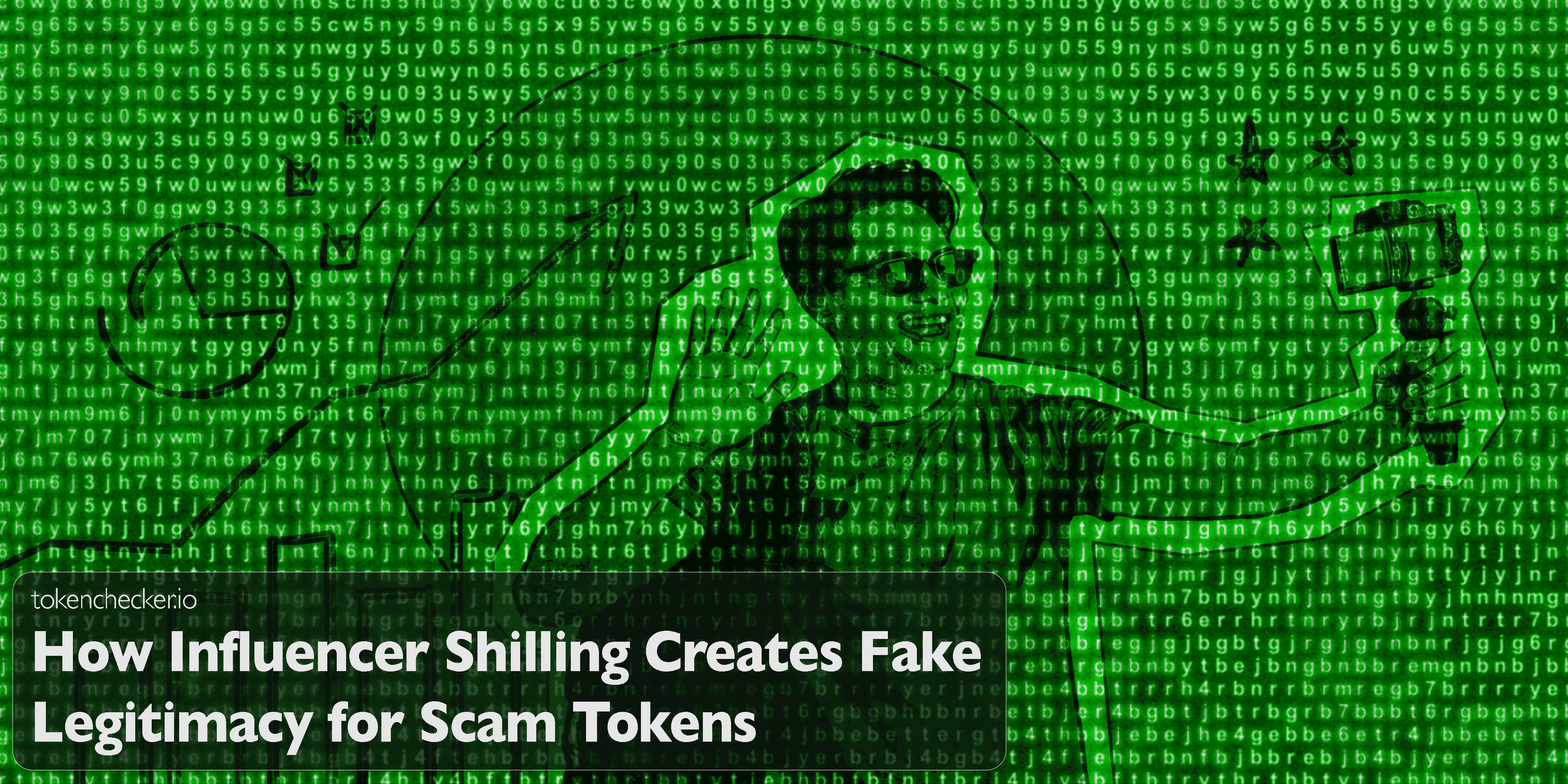
How Influencer Shilling Creates Fake Legitimacy for Scam Tokens
Crypto doesn’t just run on technology—it runs on trust. And in the digital noise of Telegram calls, Twitter threads, and viral TikToks, that trust is often borrowed. One of the most dangerous trends in Web3 today is the way influencers are used to manufacture fake legitimacy for tokens that are worthless, dangerous, or outright fraudulent.
These aren’t just paid ads. They’re carefully constructed campaigns designed to bypass your defenses, tap into social proof, and exploit the fear of missing out. In this article, we’ll break down how crypto shilling works, why it's so effective, and how tokenchecker.io helps you see through the noise.
What Is Crypto Shilling?
Shilling is the aggressive promotion of a token—usually by someone who has a financial stake in seeing it pump. It’s not always illegal, but it crosses the line when the promoter:
- Fails to disclose compensation
- Makes exaggerated or false claims
- Uses manipulative language (“100x soon,” “Don’t miss this rocket”)
- Targets non-savvy audiences without giving context
What makes crypto especially vulnerable is its dependence on social validation. Most people don’t read contracts. They look at who’s talking about it.
The Problem With “Fake Legitimacy”
Fake legitimacy is when a token looks credible but only because it was designed to look that way.
It’s built on:
- Hype from trusted influencers
- Bought followers and fake engagement
- Claims of celebrity support or institutional partnerships
- Copy-paste tokenomics and websites, a common tactic seen in stolen brand scams
These surface signals give investors the impression that a project is safe, vetted, or endorsed when it’s not. And once the illusion takes hold, it spreads fast.
Shilling Tactics That Manufacture Legitimacy
1. Hype Without Fundamentals
“Next 100x gem.” “Early alpha.” “Going viral.”
These phrases flood social media before a token even has a working product or whitepaper. It’s hype for hype’s sake built to trigger FOMO, making it one of the classic warning signs of a scam token.
2. Undisclosed Paid Promotions
Influencers often receive tokens or cash to promote a project. But when they don’t disclose that fact, they create the illusion of unbiased endorsement. This is illegal in many jurisdictions and unethical everywhere.
3. Manipulated Social Proof
Fake followers. Purchased likes. Copy-pasted community posts. These tactics make it look like a project has traction even when no real users exist.
4. Fake Endorsements
Scammers often impersonate known brands (e.g., Tesla, BlackRock) or celebrities (e.g., Elon Musk) to trick investors. One cloned website and a tweet can be enough to fool thousands.
5. Oversimplified Explanations
Some influencers mean well but don’t understand what they’re promoting. They gloss over risks, skip the contract details, and sell hype to an audience that can’t vet what they’re saying.
The Psychology Behind It
Shilling works because it taps into core investor biases:
- FOMO: You act fast because you don’t want to miss out
- Herd Behavior: Everyone’s buying, so it must be legit
- Social Proof: A big account said it’s good—why question it?
- Overconfidence: You think you can time the pump before the dump
- Recency Bias: The last token pumped—maybe this one will too
These psychological triggers override logic. And scammers know exactly how to push them.
What Happens Next
The pattern is almost always the same:
- Influencer hypes token
- Early buyers pile in
- Price spikes
- The dev wallet dumps
- The token crashes
- Retail holders are left with nothing
It’s a modern pump-and-dump scheme—just dressed up with marketing.
The Hidden Cost: Reputation and Regulation
Fake legitimacy doesn’t just burn investors. It poisons the well for everyone.
- Retail trust erodes
- Real projects struggle to gain traction
- Regulators tighten controls
- The entire space looks like a scam to outsiders
If the industry wants mainstream adoption, it can’t keep rewarding deception.
How tokenchecker.io Helps
tokenchecker.io was built to break the illusion.
Here’s how:
- Honeypot Detection: Flags tokens you can buy but can’t sell
- Creator Wallet Analysis: Shows if the dev is dumping
- Socials and Website Scan: Checks for phishing or fake links
- Originality Check: Finds clone tokens with stolen branding
- Contract Analysis: Detects minting, blacklists, and dangerous functions
- Holder Breakdown: Reveals if supply is held by insiders or bots
In other words: it shows you what hype is hiding.
Final Thoughts
Influencer shilling is modern deception. It uses the credibility of others to hide the risks of a project—and it works frighteningly well.
If you want to protect your wallet, you have to look past the surface. Not all promotion is bad. But if the only thing holding a project together is a tweet, it’s probably not a project worth holding.
Use tokenchecker.io before you buy. A few seconds of clarity can save you thousands in regret.